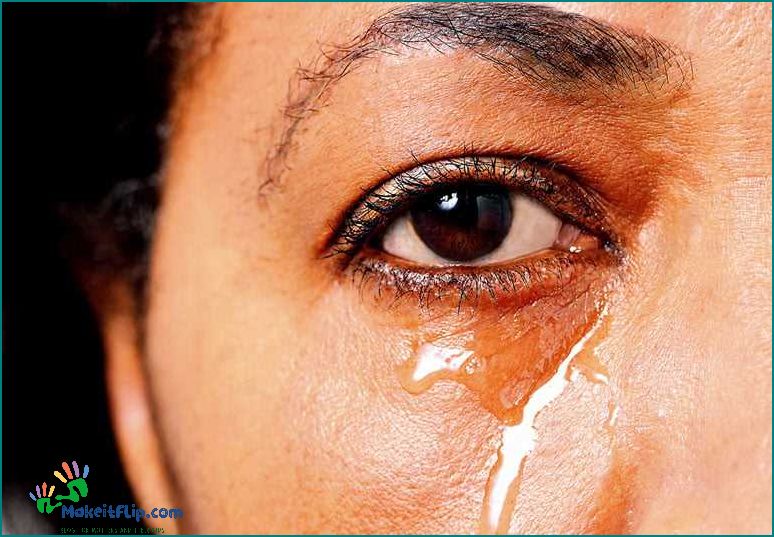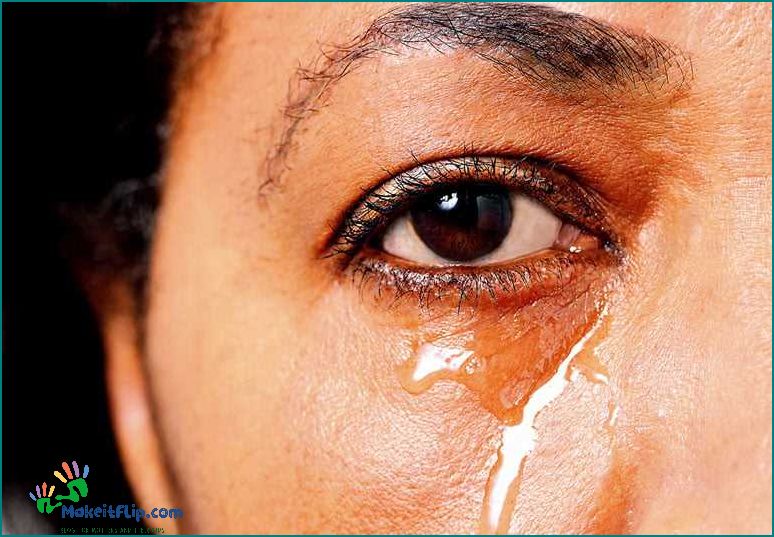Contents
The Science Behind Tears of Joy: Understanding the Emotional Phenomenon of Happy Crying

Have you ever been so overwhelmed with happiness that you couldn’t help but burst into tears? It’s a phenomenon known as happy crying, and it’s more common than you might think. Whether it’s a heartfelt moment, a touching story, or even just a good laugh, tears of joy are a powerful expression of emotion.
When we experience intense happiness, our bodies react in a variety of ways. One of the most noticeable physical responses is the smile that spreads across our faces. But sometimes, that smile is accompanied by tears. These tears are different from the ones we shed when we’re sad or in pain. They’re tears of pure happiness and they have a scientific explanation.
Research has shown that happy tears contain higher levels of certain hormones and chemicals, such as endorphins and oxytocin. These chemicals are associated with feelings of pleasure, bonding, and love. When we’re overwhelmed with happiness, our bodies release these chemicals, which can trigger the production of tears. It’s as if our bodies are trying to find a way to release the intense emotion we’re feeling.
So, the next time you find yourself crying tears of joy, remember that it’s a natural and powerful expression of happiness. Embrace the moment and let the tears flow. After all, happy crying is a beautiful reminder of the depth of our emotions and the power of a genuine smile.
Understanding the Phenomenon

Happy crying, also known as tears of joy, is a unique and fascinating phenomenon that occurs when individuals experience overwhelming happiness or joy. It is a powerful emotional response that can bring tears to one’s eyes.
When we are overwhelmed with happiness, our body’s natural response is to smile, laugh, and sometimes even cry. These tears of joy are a physical manifestation of the intense emotions we are feeling. They serve as a release valve, allowing us to express our happiness and relieve the overwhelming emotions.
Research has shown that happy tears contain different chemical compositions compared to tears shed in response to sadness or pain. They contain higher levels of endorphins, which are natural painkillers and mood enhancers. These endorphins contribute to the feelings of joy and happiness that accompany the tears.
Furthermore, happy crying is often accompanied by a sense of awe and wonder. It can be triggered by various events, such as weddings, reunions, or the birth of a child. These moments are so powerful and meaningful that they evoke a profound emotional response, leading to tears of joy.
It is important to note that happy crying is a normal and healthy emotional response. It allows us to fully experience and express our happiness, connecting us to the people and events that bring us joy. So, the next time you find yourself shedding tears of joy, embrace the moment and let the happiness flow.
The Emotional Response

Tears are often associated with sadness or pain, but they can also be a sign of happiness and joy. When we experience intense emotions, such as overwhelming happiness, our body responds by producing tears. This emotional response is commonly known as happy crying.
Happy crying is a unique and complex emotion that can manifest in different ways. Some people may shed tears of joy when they are overwhelmed with happiness, while others may experience a mixture of laughter and crying. Regardless of how it is expressed, happy crying is a natural and healthy response to feelings of immense joy and happiness.
Scientists have found that tears of joy contain different chemical compositions compared to tears shed during times of sadness or pain. These tears contain higher levels of endorphins, which are the body’s natural painkillers and mood enhancers. The release of endorphins during happy crying can contribute to a sense of euphoria and well-being.
Furthermore, happy crying can also serve as a form of emotional release. When we are overwhelmed with positive emotions, crying can help us process and express those feelings. It allows us to release pent-up emotions and can provide a sense of relief and catharsis.
Overall, the emotional response of happy crying is a beautiful and powerful experience. It is a testament to the depth of human emotion and the capacity for joy and happiness. So, the next time you find yourself shedding tears of joy, embrace them and cherish the moment of pure happiness.
The Physical Manifestation
When we experience intense emotions such as happiness, our body often reacts in various ways. One of the most common physical manifestations of happiness is a smile. A genuine smile not only involves the movement of the muscles around the mouth, but also the muscles around the eyes, creating what is commonly known as a “smile with the eyes”. This physical expression of happiness is often contagious, as it can elicit a positive response from those around us.
However, there are times when the intensity of happiness can be overwhelming, leading to tears of joy. These tears are different from tears caused by sadness or pain. They are a result of being so incredibly happy and overwhelmed with emotion that our body releases tears as a way to cope with the intensity of the moment.
Crying tears of joy is a unique experience that combines the contradictory emotions of happiness and crying. It is a physical manifestation of the joy we feel, and it often occurs during moments of extreme happiness, such as weddings, the birth of a child, or reunions with loved ones.
Laughter is another physical manifestation of happiness that can lead to tears of joy. When we find something incredibly funny, our body responds by releasing endorphins, which are chemicals that promote feelings of happiness and pleasure. This can result in uncontrollable laughter, often accompanied by tears of joy.
Overall, the physical manifestation of happiness through smiling, crying tears of joy, and laughter is a fascinating aspect of human emotion. It shows that our bodies have a unique way of expressing and coping with intense feelings of joy and happiness.
The Role of Hormones

When we experience intense emotions such as happiness, joy, or being overwhelmed with joy, our body releases hormones that can trigger tears of joy. These hormones are responsible for regulating our mood and emotions, and they play a crucial role in the happy crying process.
One of the key hormones involved in tears of joy is oxytocin, often referred to as the “love hormone.” Oxytocin is released during moments of connection and bonding, such as when we experience love, affection, or deep happiness. It promotes feelings of trust, empathy, and social bonding, and it can enhance our overall sense of well-being.
When we are overwhelmed with happiness or joy, our brain releases oxytocin, which can trigger tears of joy. These tears are often accompanied by a smile and laughter, as our body’s natural response to the intense positive emotion we are experiencing.
In addition to oxytocin, other hormones such as endorphins and dopamine also play a role in tears of joy. Endorphins are natural painkillers and mood boosters that are released during positive experiences, such as laughter or physical activity. They can contribute to the overall feeling of happiness and well-being.
Dopamine, often referred to as the “reward hormone,” is released when we experience something pleasurable or rewarding. It is involved in the brain’s reward system and can enhance feelings of happiness and joy. When we are overwhelmed with happiness, dopamine is released, which can contribute to tears of joy.
Overall, hormones play a crucial role in the happy crying process. They are responsible for regulating our mood and emotions, and they can enhance our overall sense of happiness and well-being. So the next time you find yourself shedding tears of joy, remember that it’s your body’s way of expressing intense happiness and the release of these hormones.
FAQ about topic Happy Crying The Science Behind Tears of Joy
Why do people cry when they are happy?
When people cry tears of joy, it is usually a result of intense emotions overwhelming them. The brain releases neurotransmitters like oxytocin and endorphins, which can trigger tears. Crying is a way for the body to release and express these strong emotions.
What is the purpose of crying tears of joy?
The purpose of crying tears of joy is to release and express intense emotions. It can also serve as a way to communicate these emotions to others. Crying can provide a sense of relief and help people process and cope with overwhelming feelings of happiness and gratitude.
Are tears of joy different from tears of sadness?
Yes, tears of joy are different from tears of sadness. Tears of joy are usually accompanied by positive emotions, such as happiness, gratitude, or love. On the other hand, tears of sadness are a response to negative emotions, such as grief, loss, or pain. The chemical composition of tears may also vary between tears of joy and tears of sadness.
Can crying tears of joy be beneficial for mental health?
Yes, crying tears of joy can be beneficial for mental health. It allows individuals to release and express intense positive emotions, which can provide a sense of relief and improve overall well-being. Crying tears of joy can also strengthen social bonds and enhance feelings of connection and happiness.
Is it normal to cry tears of joy?
Yes, it is completely normal to cry tears of joy. It is a natural response to intense positive emotions. Crying tears of joy is a way for the body to process and express these emotions, and it is experienced by many people in various situations, such as weddings, reunions, or achievements.
Why do people cry when they are happy?
People cry when they are happy because it is a way for their emotions to be released. Crying can be a natural response to overwhelming feelings of joy or happiness.
I’m Diana Ricciardi, the author behind Makeitflip.com. My blog is a dedicated space for mothers and their kids, where I share valuable insights, tips, and information to make parenting a bit easier and more enjoyable.
From finding the best booster seat high chair for your child, understanding the connection between sciatica and hip pain, to exploring the benefits of pooping in relieving acid reflux, I cover a range of topics that are essential for every parent.
My goal is to provide you with practical advice and solutions that you can easily incorporate into your daily life, ensuring that you and your child have the best possible experience during these precious years.
